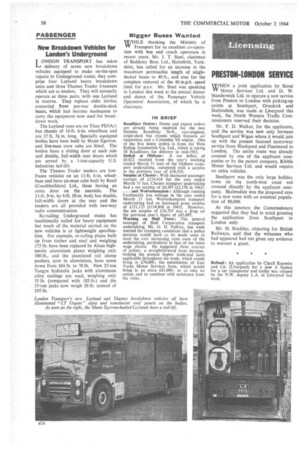New Breakdown Vehicles for London's Underground
Page 58

If you've noticed an error in this article please click here to report it so we can fix it.
LONDON TRANSPORT has taken .1—i delivery of seven new breakdqwn vehicles equipped to make on-the-spot repairs to Underground trains; they comprise four Leyland heavy breakdown units and three Thames Trader 3-tonners which act as tenders. They will normally operate as three pairs, with one Leyland in reserve. They replace older lorries, converted from pre-war double-deck buses, which had become inadequate to carry the equipment now used for breakdown work.
The Leyland vans are on Titan PD3Af I bus chassis of 18-ft. 6-in. wheelbase and are 27 ft. 51 in. long. Specially equipped bodies have been built by Mann Egerton, and five-man crew cabs are fitted. The bodies have a sliding door at each side and double, full-width rear doors which are served by a 1-ton-capacity U.S. Industries tail-lift.
The Thames Trader tenders are lowframe vehicles on an 11-ft. 6-in. wheel-. base and have six-man cabs built by Reall (Coachbuiklers) Ltd., these having an extra door on the nearside. The 11-ft. 9-in, by 6-ft. 10-in. body has double, full-width doors at the rear and the tenders are all provided with two-way radio communication.
Re-railing Underground trains has traditionally called for heavy equipment but much of the material carried on the new vehicles is to lightweight specification. For example, re-railing plates built up from timber and steel and weighing 175 lb. have been replaced by Alain hightensile aluminium plates weighing only 100 lb., and the associated rail clamp pushers, now in aluminium, have come down from 264 lb. to 70 lb. New 25-ton Tangye hydraulic jacks with aluminium alloy castings are used, weighing only 35 lb. (compared with 185 lb.) and the 15-ton jacks now weigh 26 lb. instead of 105 lb.
Bigger Buses Wanted WHILE thanking the Ministry of YV Transport for its excellent co-operation with bus and coach operators in recent years, Mr. J. T. Steel, chairman of Baddeley Bros. Ltd., Holmfirth, Yorkshire, has called for an increase in the maximum permissible length of singledecker buses to 40 ft., and also for the complete removal of the 40 m.p.h. speed limit for pay. Mr. Steel was speaking in London this week at the annual dinner and dance of the Passenger Vehicle Operators' Association, of which he is chairman.






























































































































































































































